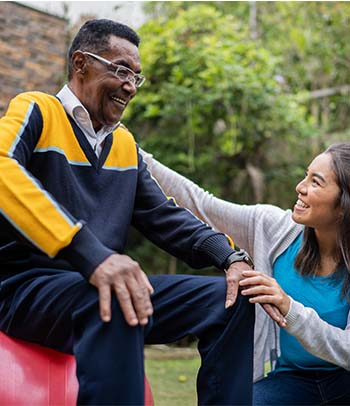Every year, approximately 800,000 people in the United States have a stroke. It is one of the leading causes of death and the most common cause of adult disability. With around 6,000 Veterans being admitted to Department of Veterans Affairs (VA) facilities each year with a stroke, it is important to know the symptoms of a stroke, what you can do to prevent one and where you can turn for help.

What Is a Stroke?
A stroke occurs when something blocks the blood supply to part of the brain or when a blood vessel in the brain bursts. In either case, a stroke can cause lasting brain damage, long-term disability or even death. However, when you know the warning signs and symptoms of a stroke, you can act quickly if you or someone you love may be having a stroke. The chances of survival increase and the amount of disability decrease when emergency treatment begins quickly.
If you notice one or more of these signs of a possible stroke, call a doctor or 911 right away:
- Sudden numbness or weakness of face, arm or leg, especially on one side of the body
- Sudden confusion or trouble talking or understanding speech
- Sudden trouble seeing in one or both eyes
- Sudden trouble walking, dizziness or a loss of balance or coordination
How Can I Minimize My Risk for Stroke?
You can’t control your age or your family history, but you can take steps to greatly lower your chances of having a stroke. You can begin by making healthy lifestyle choices and managing any health conditions you have that may increase your risk of stroke.
You can’t control your age or your family history, but you can take steps to greatly lower your chances of having a stroke.
- High cholesterol and high blood pressure increase your risk of stroke, so eating a diet low in saturated fat and cholesterol and high in fiber can reduce your stroke risk.
- Obesity or being overweight can increase your risk of stroke, so maintaining a healthy body weight can help. The Centers for Disease Control and Prevention (CDC) offers a tool to help you assess your body weight.
- Physical activity can help you maintain a healthy weight and lower your cholesterol and blood pressure. Aim for 2.5 hours of activity a week. You can achieve this through five 30-minute walks or a few longer walks or activities during the week.
- Cigarette smoking can increase your risk of stroke, so if you are a smoker, make a plan to get help and quit.
- Certain health conditions increase your risk for stroke if not managed properly. Talk to your doctor about ways to manage and treat conditions, such as high blood pressure, diabetes, high cholesterol and heart disease.
These are small, concrete ways to have a big impact on your risk for stroke. There are other factors beyond your control that can be discussed with your health care team, including:
- Genetic factors—several genetic disorders, including sickle cell disease, can cause a stroke, as well as a family history of high blood pressure or stroke in your family.
- Your age—the older you are, the more likely you are to have a stroke.
- Your gender—stroke is more common in women than men.
- Your race—people who are Black, Hispanic, American Indian and Native Alaskan may be more likely to have a stroke than non-Hispanic whites or Asians.

Where Can I Get Help?
According to VA, Veterans make approximately 60,000 stroke-related outpatient visits annually. With the prevalence of stroke in the Veteran community, VA offers several resources to help families deal with stroke and its long-term effects.
- Resources and Education for Stroke Caregivers’ Understanding and Empowerment, or RESCUE, is a lifeline for caregivers who are not always prepared for the challenges of taking care of a stroke victim. RESCUE provides tons of great information and resources, including 45 easy-to-read fact sheets on topics, such as managing financial and legal issues, locating community resources and keeping your loved one healthy. You can also find tools to help you learn practical information, such as how to lift and transfer your loved one out of bed and how to organize your loved one’s medical records.
- VA Caregiver Support Program provides a great list of both VA and non-VA resources including information on long-term care or community-based services, Medicare, the Veterans Crisis Line and much more.
- VA’s Caregiver Support Line is available at 855-260-3274 to learn more about the support available to you and your loved ones.
- Your local Caregiver Support Coordinator is a licensed professional who can support you by matching you with services for which you are eligible and resources that can help you care for the Veteran you love.
In addition, check out these resources for more information:
- The National Institute of Neurological Disorders and Stroke offers Brain Basics, a ton of helpful information on stroke and how to prevent it, as well as a risk assessment tool you can use.
- The CDC offers Live to the Beat, a great tool to help you get started making small, heart-healthy choices that work best for your lifestyle.
A stroke can happen to anyone at any age. It’s important to manage your risk and understand the signs to look for. We can all take positive steps toward preventing a stroke for ourselves and our loved ones.







